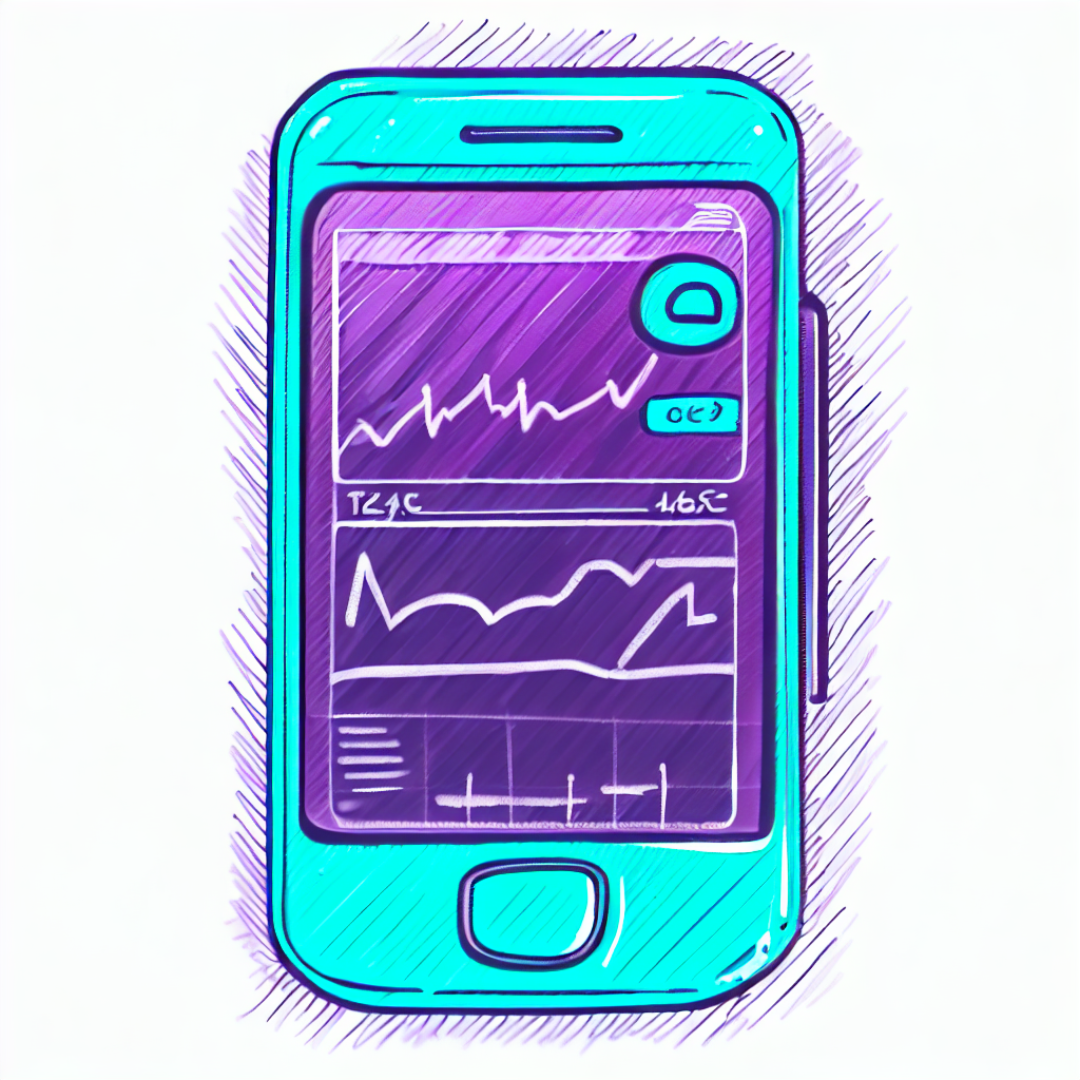So by now you know that I’m very interested in nutrition, food science, and quantified self, you also know that I follow a low carb/keto lifestyle. Therefore it’s likely not a surprise to hear that I’ve been testing out a program/service that provides a Continuous Glucose Monitor (CGM) for more analytics and insights into my body and how it responds to the food I eat.
A Little Backstory
I’m fortunate to have started my professional career in pharmacy. This career start gave me a lot of confidence in the world of medicine, prescription drugs, and general jargon. Specifically, that it’s something anyone can get started in and learn about (read as: it’s not that scary). So when ads started popping up in my social media feeds, Instagram in particular, marketing CGMs to people of all types (not just those with a chronic condition or diagnosed with Diabetes) I was intrigued. That intrigue finally turned into action in late March of 2023.
Now I will start by saying that there are several companies offering these type of programs and at it’s core, I think they all offer a very similar service. Access to a CGM, some nutritional guidance and education, and an app that includes a tracking and reporting interface. There were two that rose to the top during my search (most likely due to their social media marketing efforts), Nutrisense and Levels Health. Worth noting these companies all rely on mainstream CGM devices by reputable companies (Abbott & Dexcom) whose names are very familiar to me from my pharma days (Big tangent: I even thought that a CGM might be OTC because a traditional fingerstick Glucose Monitor is OTC and did some research on if I could purchase one without an RX – at time of writing that’s not possible).
Anyway, I did some research and homework, which relied heavily on a few factors for me.
- Ease of getting started – how hard would it be to get the meter to my house and start tracking
- Pricing – how much are the add-on/value add services that I may not use compared to the overall price of the CGM they’re offering
- User Interface and Experience – what exactly do the analytics and charts look like (obviously I care since I make charts for a living)
So at the end of the day I selected Nutrisense. I spent some time reviewing images and hashtags on Instagram and also looking for pictures of their app. I had also done research to learn about what type of CGM they prescribe and was pretty confident it would be a FreeStyle Libra – which users report has a wonderful standalone app (this was what I was going to get if I could have done OTC). So armed with all of that, I got started.
Now I won’t bore you with too many details – it’s worth saying that Nutrisense has a few different pricing models, starting at $299/month for a 3 month commitment, reducing to $250/month for 6 months, and $225 for a full year. I selected the 3 month plan because 90 days felt sufficient for my initial trials. I didn’t want to lock myself into a year if it proved to be not helpful or useful (FYI: my research indicated that a CGM is about $80-$150 shelf price, so the idea that I could get 2 for around the same price + the app was a no-brainer).
Onboarding Experience
Onboarding was very easy. I signed up using my email address, entered some information in, shared a picture of a valid ID, and within a week I had a FreeStyle Libra CGM at my doorstep (via USPS shipping). I did this all from my phone. Nutrisense uses 3rd party pharmacies for fulfillment, so it was very seamless. Essentially Nutrisense creates a platform for a provider to write me a prescription for the CGM, then submits that prescription to a pharmacy, and voila it’s mailed to my door. Worth mentioning: the prescription is for 30 days (really 28) without a refill, so they are submitting new RXs each month of billing.
The First 24 Hours
So you’ll find a lot of videos about people applying their CGM and they all have expressions of “wow I didn’t feel anything.” And that’s totally accurate. Nutrisense has a simple tutorial in their app with GIFs showing how to apply and includes tips – their biggest tip being to put it on a fatty part of your arm (not really a problem for me, I hold a lot of weight in my arms). I absolutely could not feel it when I applied it. The best way to describe what happens is that the applicator is like a threaded needle. The applicator itself has a needle that breaks through the skin, but doesn’t remain with you, it stays with the applicator. What’s left inserted into your arm is what I will describe as a thick black thread/fiber. The CGM has a very thick and sturdy adhesive, unlike any bandage adhesive I’ve experience. Nutrisense also provides a circular bandage for more protection over the top of the meter (I also think it is a branding/marketing tactic).
After about an hour, you can start getting your readings from the CGM. And that’s when all the fun began. In particular, Nutrisense promises to score each of your meals that you track in their app – providing analytical feedback on the 2 hours post consumption on how it impacts your body. And that’s really key here – food impacts every body differently. Most science and nutrition you find is comprised of aggregates/averages and theoretical norms. With a CGM you know exactly how your body reacts. And even more to the point – food impacts you differently at different times due to other factors (this was very eye opening to me).
When you get started, there’s a lot of educational information, but the most important thing to consider is that you’re running nutrition experiments. Experiments that will work best with an amount of control – so the advice given was to start eating meals or foods, but space them out deliberately so you can see how your glucose responds. That means a +2 hour window after consumption to fully process the food.
And thus it began. I will say that I track all of my foods in an app called Lose It! (I’m sure I will do a deep dive on this at some point). Because I was already using Lose It! consistently to track meals, the inclusion of the CGM wasn’t too hard to manage. I personally found Nutrisense’s meal tracking app to be decent, but it just can’t compete with the customized food library I’ve built up in Lose It! (been using it since 2016) or the user entry base (more people on the Lose It! platform than Nutrisense means a larger crowd-sourced food database). To combat that, I decided to default to recording meals and timestamps in Lose It! and backfilling Nutrisense every few days. This actually worked really well, because I was able to see the immediate results in Nutrisense, but stay in the flow of my normal lifestyle using Lose It!
Interesting findings and how Nutrisense has helped:
So I wanted to end this post by showing you some charts that are illustrative of what you’ll find in the app. For each of these charts, you can click on the image to see a fully interactive version if you prefer. Worth mentioning, the range between 70 and 140 is considered “normal” for those without any health conditions.
Let’s look at some breakfast experiments!
Experiment #1
A cup of coffee with half & half and liquid sucralose sweetener (I swear by EZ-Sweetz) with Mint Leos (remember those from my Top 5 Keto Snacks post).

Results aren’t too bad. My fasting blood sugar directly at time of eating was 89, it peaked at 124 after about an hour and a half, and then was approaching pre-meal at the 2 hour mark (99). This breakfast varies each time I eat it, but has become one of my staples.
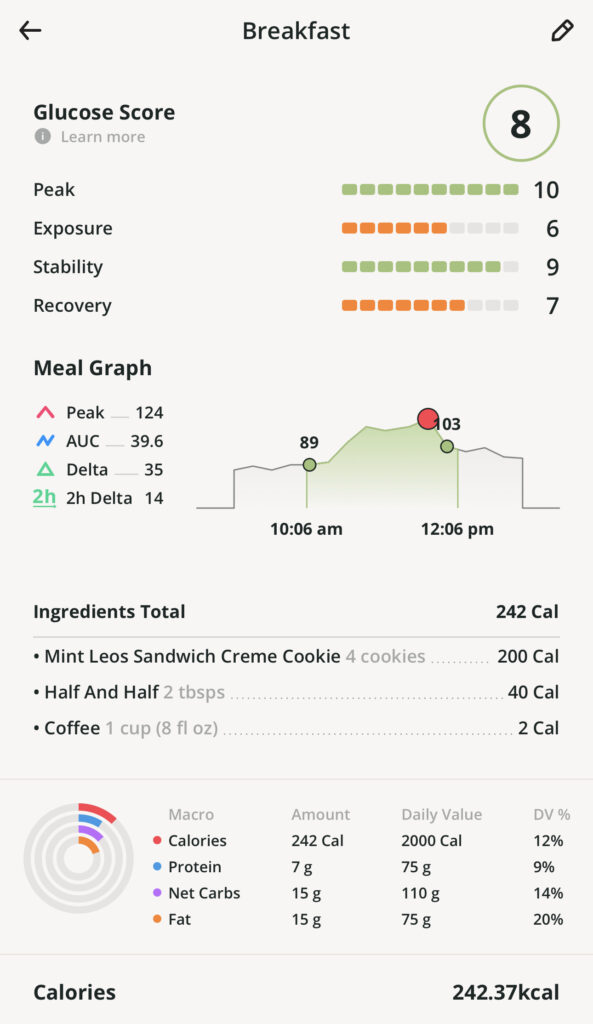
Nutrisense scored this meal as an 8 out of 10 (good meal)- noting that it did cause my glucose to rise 35 points (the delta) and that after 2 hours my glucose wasn’t quite at pre-meal values which would be ideal.
Experiment #2
A cup of coffee (same as above) and a pint of Nick’s Chocolate Ice Cream.
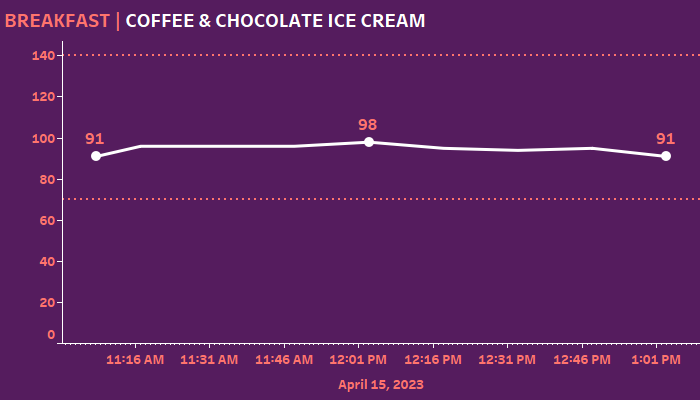
Holy sh!t! These results feel almost like cheating at life. Look at that line – it’s nearly flat across the 2 hours, peaking at just 7 points higher than my pre-meal measurement. Interestingly, Nick’s uses Allulose to sweeten their ice cream, which creates a weird nutrition label (at time of writing, although Allulose doesn’t impact glycemic index, label regulations are still catching up as to where it is classified). And remember, this is a pint of ice cream, which takes at least 10 minutes to eat.
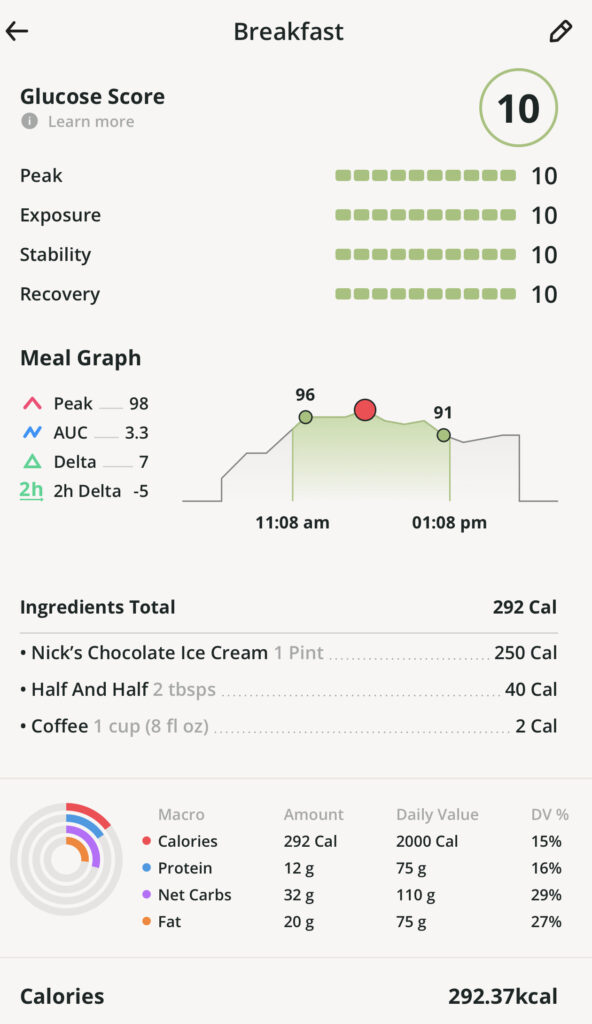
And look at that, Nutrisense scored this meal as a perfect 10. 💃 No surprise there, based on what I shared. Glucose barely moved and it tracked it at a slight drop from start. This is exactly the value of a CGM – because as I said Allulose is not labeled very clearly, so who knows what the impact could be (I know we all want to trust what manufacturer’s say, but now I have irrefutable evidence). My takeaway: ice cream for breakfast, not such a bad idea 😜
Experiment #3
Coffee & Brownie Crisps by Bantastic made from green not-yet-ripe bananas. These were something new I found and wanted to try specifically because they are chocolate (see the breakfast theme yet?) and they have a crispy crunchy texture. On the Amazon product page it specifically says “these keto brownies won’t spike your blood sugar.” They’re also pretty low calorie per each serving.
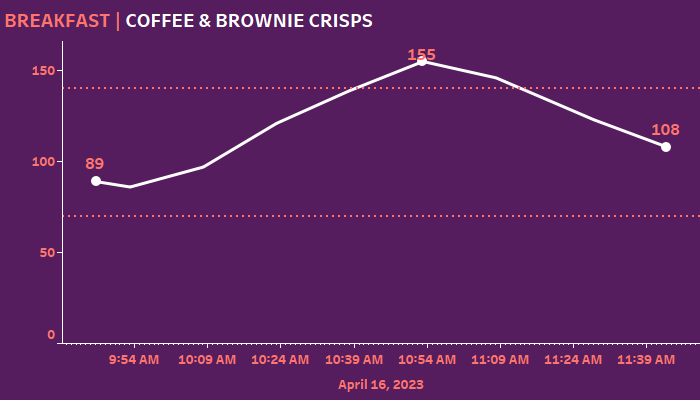
When I saw this, let’s just say I wasn’t pleased. How could something so simple and low in calories spike my glucose so much? And if you look at the curve it happens almost instantaneously. While doing a low carb lifestyle and in all the time I have been using the CGM, this was the first time I saw it spike over 140 while trying to actually eat keto. Nutrisense also offers a complimentary month with a Nutritionist and she immediately flagged it as well. She categorized this something that I should have “as a treat.” She also recommended I do a few more experiments and each time I got similar results. My nutrition intuition goes back to bananas being the most sugary fruit (whether this is fact or just what’s stuck in my head) and that somehow even though they’re underripe, the sugar that exists in bananas must be extremely potent. Sadly these crisps ended up in the “I will never buy them again” bucket. But honestly, if I didn’t have the data, who knows.
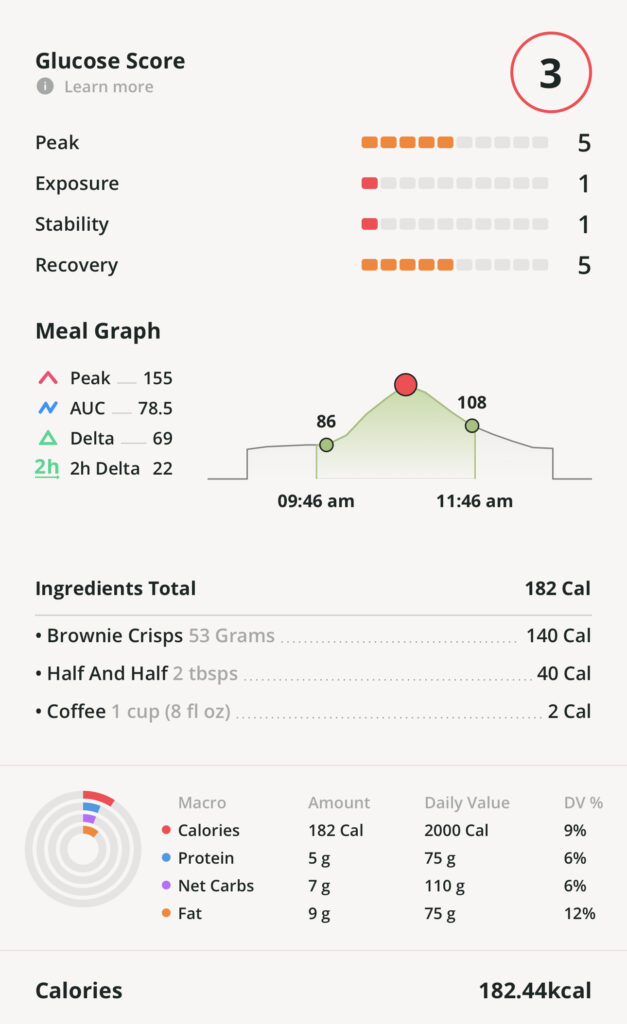
Experiment #4
Brunch at Snooze AM Eatery. So this is my eating out experiment. Snooze AM Eatery is our absolute favorite place to eat breakfast and brunch. They offer lots of healthy and bougie options (they have a kick-ass Spicy Bloody Mary), have a commitment to sustainability, and only do breakfast. My partner loves a good breakfast, so this tends to be our go-to place if we want to get out of the house. I like their Protein Veggie Egg White Scramble with Chicken Sausage in particular – it’s basically an egg white omelet with delicious sausage (note it comes with avocado, which I don’t eat or include in my calculations). The dish is so healthy that I even get to sneak in a piece of their Signature Bacon.
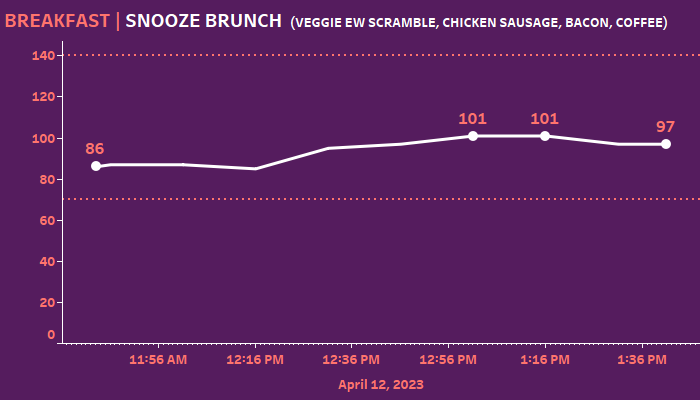
And the results match my love for the meal – a slow climb that flattens out right at 100 (fine 101) and returns to near pre-meal values. This even includes 2 cups of coffee. I wonder on this one if results are stretched out because I tend to eat slower at restaurants. Either way, I’m pretty pleased with how this turned out. And I recently went back and added in their Spicy Bloody Mary – this time my results were even more impressively low, not even climbing to 100.
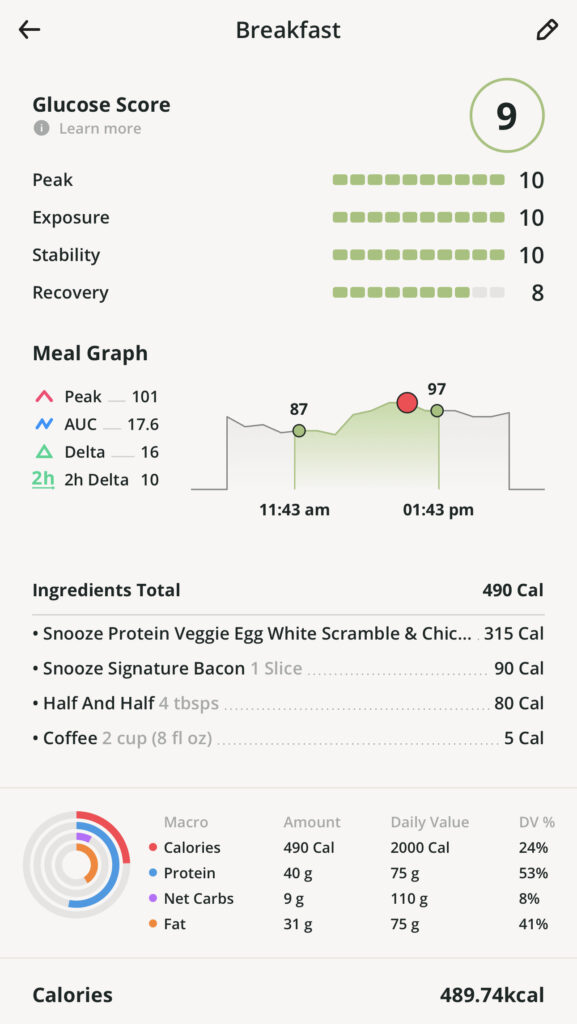
I’m now more than a month in to monitoring (end of week 6) and have to say I’ve been very pleased with the CGM addition to my lifestyle. For those who may be wondering if it causes a lot more administrative overhead or takes away the joy of eating – I want to tell you it has the opposite effect. To me nothing is more powerful than seeing my individualized response and understanding the impact of the food. It’s actually helped me enjoy an occasional non-keto meal without worry.
If you made it to the end and are interested in Nutrisense, I highly encourage you to check them out. They do offer a referral program, which saves us both $50. You can sign up using this link.
P.S. A small note on calibration and accuracy. I also have a normal Glucose Monitor (specifically this GK+ Monitor from Keto Mojo) which I used to ensure that the CGM measurements matched output from a traditional fingerstick.
